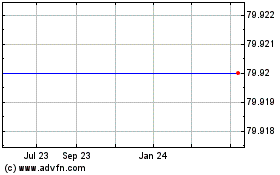By Khadeeja Safdar
Victoria's Secret has a problem and it's not much of a secret:
athleisure is upending the bra business.
Growth is slowing in the retailer's core bra business, which
accounts for about 35% of sales at its parent company, L Brands
Inc., as shoppers seek comfort instead of flash from their
undergarments. In the first quarter, the retailer said bra sales
rose less than 10%, down from growth rates in the mid-teens in
prior quarters. Shares of L Brands have tumbled 29% so far this
year.
"It's not a sick business but it's not growing at the rate we
want," the company's finance chief, Stuart Burgdoerfer, said in
May. The retailer has taken steps in recent months to fix the
issue. It has brought in new leadership, pared its merchandise and
responded to the athleisure trend.
Victoria's Secret is setting aside more space in stores for
sports bras and in April released a collection of "bralettes" --
bras without underwire and padding. In the past weeks, it began
aggressively marketing its new line using window displays and email
messages that say "no padding is sexy." In one recent TV
commercial, models are running across a field of tall grass and one
tells the other that she likes "being free!"
At issue is a fundamental shift in what female consumers want
from their undergarments and how much they are willing to pay.
Victoria's Secret has powered years of growth with images of busty
models at more than 1,000 largely mall-based stores and a selection
of padded bras retailing at prices up to $60. But many young
consumers now prefer more authentic marketing and garments that
resemble crop tops, with simple sizing and prices around $20.
"There's a move toward more natural looks. That's hurtful to
Victoria's Secret," said Jefferies analyst Randal Konik, because if
more people buy cheaper bras, total sales will suffer.
Executives at L Brands declined to comment.
A recent report by market research firm NPD Group found that 41%
of female millennials had worn a sports bra in the past seven days,
compared with 21% of non-millennials. "Comfort is a dominant theme
throughout the fashion world, and today's bra consumer...is seeking
both physical and personal comfort," said Marshal Cohen, chief
industry analyst at the NPD.
Rivals have capitalized on the shifting consumer preference.
Sales at American Eagle Outfitters Inc.'s lingerie brand, Aerie,
have soared since the teen retailer stopped airbrushing its ads and
began featuring models in various shapes. The company also got an
early jump selling bralettes.
The shift toward comfort is more than just a fad, according to
Aerie brand president Jennifer Foyle. "The next generations coming
up the pike are particularly more comfortable in their own skin,"
she said.
Many online lingerie startups are also gaining traction by
providing alternatives to Victoria's Secret, both in terms of style
and marketing. True&Co. introduced a fit quiz to cater to women
of various shapes. Lively makes everyday undergarments using
elements from athletic clothes and swimwear. ThirdLove features
models who look away from the camera, a stark contrast from
Victoria's Secret's come-hither marketing.
"You have these other brands that are less so overtly sexy and
much more focused on being natural," said Nomura analyst Simeon
Siegel. "It's too early to say it will steal a dramatic share from
Victoria's Secret but it's not too early to say that there's a real
consumer preference for it."
But the pivot is hard for Victoria's Secret, which was built on
affectation, not authenticity. In the mid-1990s, its heavily padded
Miracle Bra, designed to create cleavage, was vying for market
share with Sara Lee Corp.'s Wonderbra. Victoria's Secret doubled
down on advertising with provocative TV commercials and theatrical
fashion shows and in 2004 launched PINK, a brand aimed at teens and
preteens.
It was a formula that served the company well. Victoria's Secret
had $7.67 billion in revenue last year and now controls more than
60% of the women's intimate apparel market in the U.S., according
to IBISWorld. It has reported sales growth in the U.S. and Canada
every year for the last six and it continues to expand its fleet of
stores wringing out more sales per average square foot each
year.
But L Brands executives are aware that the business needs a
marketing revamp. Last year, Victoria's Secret Fashion Show tripped
on the catwalk as CBS ratings dropped 32% from 2014.
"They have realized that their traditional brand marketing is
aging and it's not really connecting with modern-day consumers,"
said Cora Harrington, editor in chief of the Lingerie Addict
blog.
In February, longtime L Brands Chief Executive Les Wexner
stepped in to take charge after the sudden departure of Victoria's
Secret CEO Sharen Turney. He made dramatic changes, including
exiting the $500 million swim, shoes, apparel and accessories
business, and substantially reducing its famous catalog. The
company hired Jan Singer, former CEO of rival brand Spanx, to run
its lingerie business starting in September.
Taylor Petersen, a 23-year-old who lives near Chicago, said she
is turned off by Victoria's Secret's marketing and prefers
"natural-looking" undergarments. "I just want to feel like myself
instead of feeling trapped all day," she said.
Write to Khadeeja Safdar at khadeeja.safdar@wsj.com
(END) Dow Jones Newswires
June 29, 2016 12:49 ET (16:49 GMT)
Copyright (c) 2016 Dow Jones & Company, Inc.
LandBridge (NYSE:LB)
Historical Stock Chart
From Jun 2024 to Jul 2024

LandBridge (NYSE:LB)
Historical Stock Chart
From Jul 2023 to Jul 2024
